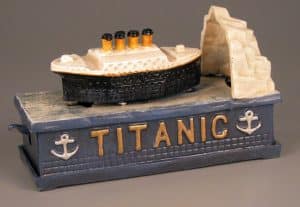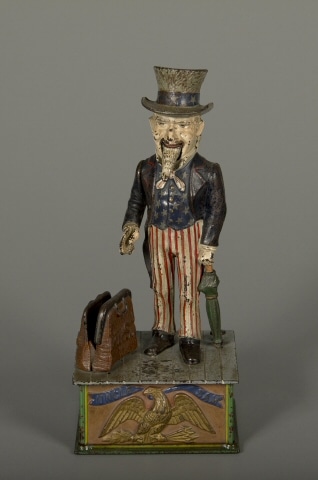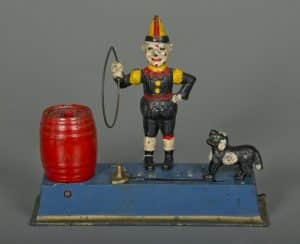 Looking for a safe place for your savings? With today’s tumultuous stock market (even Mark Zuckerberg is losing money) and bank bailouts of the recent past, it’s no wonder that most of us feel a bit uncertain about the best place to store our money. How about a mechanical bank? For years these cast-iron collectibles proved a suitable spot for stashing cash, not only because they offered lock and key security, but because they made putting money away fun, encouraging saving over spending.
Looking for a safe place for your savings? With today’s tumultuous stock market (even Mark Zuckerberg is losing money) and bank bailouts of the recent past, it’s no wonder that most of us feel a bit uncertain about the best place to store our money. How about a mechanical bank? For years these cast-iron collectibles proved a suitable spot for stashing cash, not only because they offered lock and key security, but because they made putting money away fun, encouraging saving over spending.
Mechanical banks originated in the late 19th century and remained popular for nearly 60 years. Intended to encourage youngsters to save their pennies, the banks came from established companies, most of whom produced toys, tools, or hardware. Toy manufacturer J. & E. Stevens of Cromwell, Connecticut, crafted the first cast iron mechanical bank in 1869 and continued production for more than half a century, making Stevens one of the most widely recognized mechanical bank producers. Stevens—as well as other manufacturers—chose cast iron as the medium for its abundance and availability. Skilled iron workers allowed toy firms to craft their products into a variety of shapes and figures with an acute sense of detail.
 Mechanical banks often reflected the political, religious, and cultural beliefs of the era. For instance, Shepard Hardware Co. of Buffalo, New York, manufactured two such banks, one portraying Uncle Sam and the other depicting the biblical story of Jonah and the Whale, both of which proved quite popular. The Tammany Hall Bank, issued by J. & E. Stevens in 1875, served as commentary on New York City’s corrupt political organization and the iconic “Boss Tweed” who was imprisoned in 1873 for embezzling public funds. The bank features a heavy-set man sitting in a chair marked “Tammany Bank.” Placing a coin in the man’s right hand causes it to fall into a slot behind his left arm, and the man bows his head as if in thanks. Historical events like the World’s Columbian Exposition often received commemoration in cast iron, such as the World’s Fair bank. Even tragic events, such as the 1912 sinking of the Titanic, served as inspiration for a bank or two, although not until several years later.
Mechanical banks often reflected the political, religious, and cultural beliefs of the era. For instance, Shepard Hardware Co. of Buffalo, New York, manufactured two such banks, one portraying Uncle Sam and the other depicting the biblical story of Jonah and the Whale, both of which proved quite popular. The Tammany Hall Bank, issued by J. & E. Stevens in 1875, served as commentary on New York City’s corrupt political organization and the iconic “Boss Tweed” who was imprisoned in 1873 for embezzling public funds. The bank features a heavy-set man sitting in a chair marked “Tammany Bank.” Placing a coin in the man’s right hand causes it to fall into a slot behind his left arm, and the man bows his head as if in thanks. Historical events like the World’s Columbian Exposition often received commemoration in cast iron, such as the World’s Fair bank. Even tragic events, such as the 1912 sinking of the Titanic, served as inspiration for a bank or two, although not until several years later.
While general interest in mechanical banks declined after 1930, cast iron buildings, figures, animals, and vehicles remain highly sought after amongst collectors. Although not a collector, I find myself intrigued by the banks and have been impressed by several in the diverse collection at the National Museum of Play at The Strong. As a child, I was fascinated by an iron puzzle bank my father owned. With the press of a button, all four walls of the bronze patina building collapsed, causing the change inside to spill out dramatically—the very sight of which made me feel just a bit wealthier. Although it’s not mechanical, this sort of action is enough to pique the interest of nearly anyone (including my mother and older siblings) but also encourages saving; the more change you drop in, the more impressive it is when it spills out. To this day, my dad still stores change in that bank. I can’t help but wonder if it’s because it makes him feel like a kid again, or if it’s because he thinks it’s a safer investment.
 So if you’re looking for a new hobby and a secure place for that extra bit of cash, perhaps mechanical banks are the way to go. They come in a variety of shapes and sizes (how about a Trick Dog or maybe an Owl?), provide a bit of entertainment, and offer added peace of mind that your money is safe in iron-clad surroundings.
So if you’re looking for a new hobby and a secure place for that extra bit of cash, perhaps mechanical banks are the way to go. They come in a variety of shapes and sizes (how about a Trick Dog or maybe an Owl?), provide a bit of entertainment, and offer added peace of mind that your money is safe in iron-clad surroundings.
 Hours 10 a.m.–5 p.m. | Fri. & Sat. till 8 p.m.
Hours 10 a.m.–5 p.m. | Fri. & Sat. till 8 p.m.